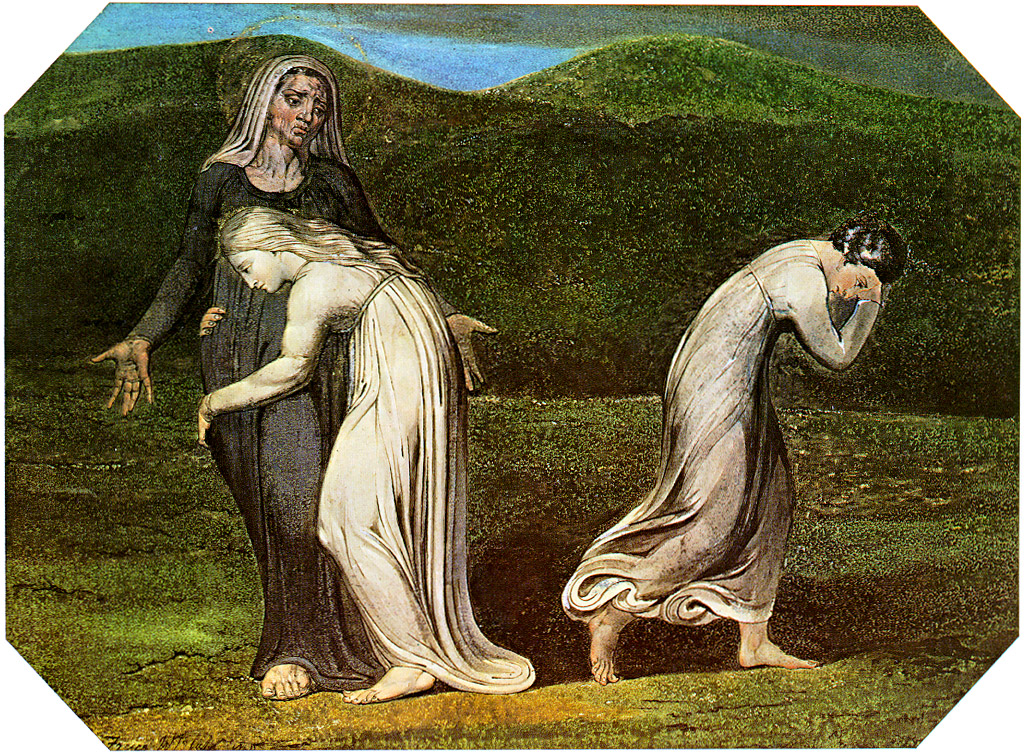[11] But Na'omi said, "Turn back, my daughters, why will you go with me? Have I yet sons in my womb that they may become your husbands?
[12] Turn back, my daughters, go your way, for I am too old to have a husband. If I should say I have hope, even if I should have a husband this night and should bear sons,
[13] would you therefore wait till they were grown? Would you therefore refrain from marrying? No, my daughters, for it is exceedingly bitter to me for your sake that the hand of the LORD has gone forth against me."
[14] Then they lifted up their voices and wept again; and Orpah kissed her mother-in-law, but Ruth clung to her.
[15]And she said, "See, your sister-in-law has gone back to her people and to her gods; return after your sister-in-law."
[16] But Ruth said, "Entreat me not to leave you or to return from following you; for where you go I will go, and where you lodge I will lodge; your people shall be my people, and your God my God;
[17] where you die I will die, and there will I be buried. May the LORD do so to me and more also if even death parts me from you."
 |
| Wikimedia Large Color Prints Naomi Entreating Ruth and Orpha |
Blake uses this image as an indication that the return involves a reintegration of the emanation into the complete man. Ruth exemplifies the willingness to forgo selfish interest as an expression of her love for her husband's family.
Four Zoas, Night IX, Page 133, (E 402)
"Not for ourselves but for the Eternal family we live
Man liveth not by Self alone but in his brothers face
Each shall behold the Eternal Father & love & joy abound
So spoke the Eternal at the Feast they embracd the New born Man
Calling him Brother image of the Eternal Father."
Jerusalem, Plate 96, (E 255)
"Jesus replied Fear not Albion unless I die thou canst not live
But if I die I shall arise again & thou with me
This is Friendship & Brotherhood without it Man Is Not
So Jesus spoke! the Covering Cherub coming on in darkness
Overshadowd them & Jesus said Thus do Men in Eternity
One for another to put off by forgiveness, every sin
Albion replyd. Cannot Man exist without Mysterious
Offering of Self for Another, is this Friendship & Brotherhood
I see thee in the likeness & similitude of Los my Friend
Jesus said. Wouldest thou love one who never died
For thee or ever die for one who had not died for thee
And if God dieth not for Man & giveth not himself
Eternally for Man Man could not exist. for Man is Love:
As God is Love: every kindness to another is a little Death
In the Divine Image nor can Man exist but by Brotherhood"
Jerusalem, Plate 62, (E 212)
[Voice of the Lord]
"Repose on me till the morning of the Grave. I am thy life.
Jerusalem replied. I am an outcast: Albion is dead!
I am left to the trampling foot & the spurning heel!
A Harlot I am calld. I am sold from street to street!
I am defaced with blows & with the dirt of the Prison!
And wilt thou become my Husband O my Lord & Saviour?
Shall Vala bring thee forth! shall the Chaste be ashamed also?
I see the Maternal Line, I behold the Seed of the Woman!
Cainah, & Ada & Zillah & Naamah Wife of Noah.
Shuahs daughter & Tamar & Rahab the Canaanites:
Ruth the Moabite & Bathsheba of the daughters of Heth
Naamah the Ammonite, Zibeah the Philistine, & Mary
These are the Daughters of Vala, Mother of the Body of death
But I thy Magdalen behold thy Spiritual Risen Body"
.

No comments:
Post a Comment